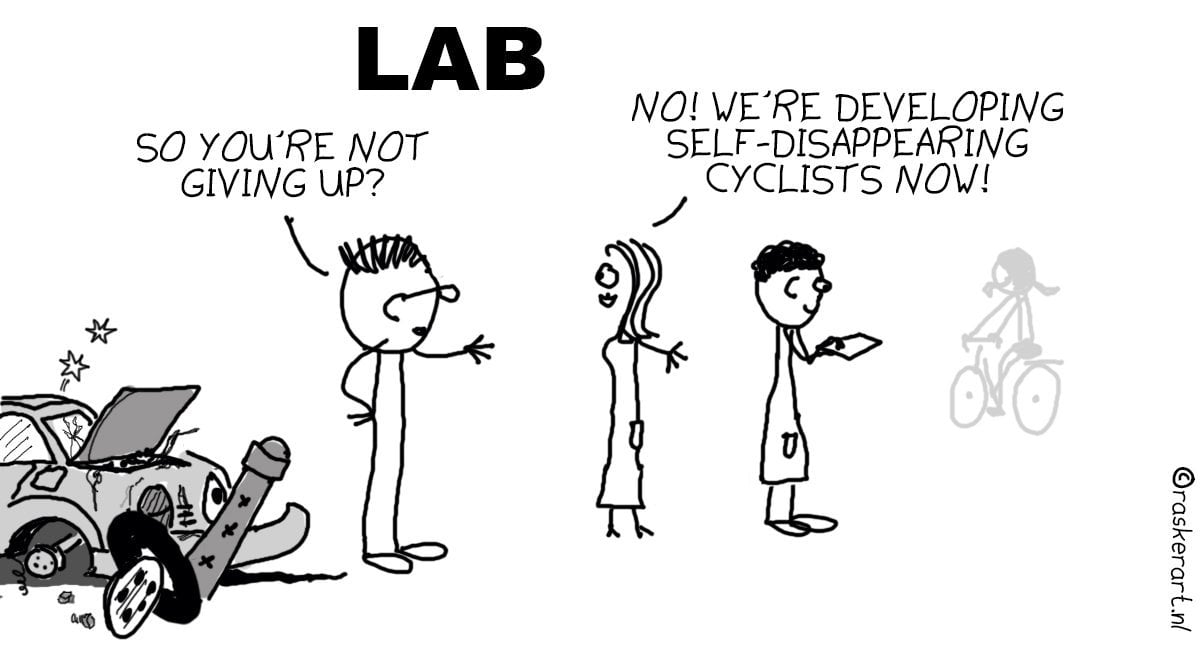
Trams, cats, colliding cyclists – they can make it pretty difficult for self-driving cars. Especially in a city like Amsterdam. Carlo van de Weijer, director of the recently opened Eindhoven Artificial Intelligence Systems Institute (EAISI), thinks that it will never work. Let autonomous vehicles drive through our busy main city? “That can’t be done,” according to Van de Weijer. That’s what came out of our best read article this week.
Still, that all sounds rather set in stone. Ten years ago, nobody would have predicted that we could transform leftovers into decorative edible tidbits with a 3D printer. Is a self-driving car in a city like Amsterdam really so inconceivable?
Just this past summer, a TU Delft research team presented a milestone for self-driving cars in cities. The researchers designed a system that analyses and predicts pedestrian behaviour. “It is a system that covers the entire processing chain, from vehicle perception, situation analysis and planning to control,” said lead researcher Dariu Gavrilla at the time.
At least another 30 years
In other words: a self-steering car that is able to predict whether a pedestrian will stay waiting patiently at a curb, or choose to cross the street. “We are one small step closer to being able to roll out autonomous driving effectively in a busy, urban setting,”,said Gavrilla. Would that mean self-driving cars will be lining the Amsterdam canals? Things won’t go that fast, Gavrilla also believes: “A car that can drive through a city and be as adaptable as a human driver – that’s going to take at least another thirty years,” he told the Dutch broadcast service NOS in August.
So, things will still be a long time coming, although it certainly doesn’t seem inconceivable. That’s how trend-watcher and Tesla driver Vincent Everts views it too. “I already use the autopilot function on 95 % of my trips,” he says. “Especially on the highway, but also in the city if the road is suitable enough.” The only condition is that the roads have to be clear. “I hardly ever use it on inner city streets, but there are no lanes there and things jut out all over the place,” Everts says. “The car is not at all ready for that yet.” But will it be possible someday?
Read more about self-driving cars at Innovation Origins here.
“Not tomorrow, nor the day after tomorrow, but I do see it happening within ten years,” Everts predicts. Everts and Van de Weijer know each other very well, however, they disagree on the future of self-driving cars. “Van de Weijer thinks that self-driving cars will only be able to anticipate the aggressive behaviour of human drivers and never be able to push ahead in traffic themselves. That’s not what I think.”
Tests in Jeruzalem and Tel Aviv
Everts points to a number of manufacturers as a counterargument. Mobileye, an Israeli company which was acquired by Intel in 2017, produces camera systems for the automotive industry. In particular for self-driving cars. “Mobileye does all the tests in Jerusalem and Tel Aviv, because if you’re not ultra-aggressive there, you’ll never get anywhere.”
Aggressiveness – it may sound like something that should be kept out of traffic at all costs. Yet the borderline between aggressiveness and assertiveness is quite fine at times. In order to be able to navigate independently through a busy city, a self-driving car must now and then be able to take the lead when it has the right of way. But still be able to immediately react and brake if it doesn’t get it.
And this is a choice that rests with us, Everts argues: “Computers can definitely exert a certain level of assertiveness.” He makes a comparison with the financial markets. “Eighty percent of stock acquisitions are made by computers. These are considerably aggressive actions and that can be done in traffic as well, of course. Except that it is far more important that clear legislation is put in place as to how aggressive.”
Stricter rules
The rules for computer systems in autonomous cars will be much stricter than how people act in real-life, says Everts. Though self-driving cars have dozens of cameras, and see everything that goes on around them all the time. As a result, Everts states that they will ultimately be able to drive more safely than people – who frequently don’t pay full attention to traffic.
“Legislators do see that perspective. Self-driving cars will cause far fewer fatalities. What is now in the news a lot, are cars with systems that are still in the beta phase and are not being used properly. That’s how people get killed.” And that is misleading, as far as Everts is concerned. Still, Everts thinks that in the foreseeable future, we will have advanced the software far enough so that self-driving cars can be used in these situations. “Within five years, the software will have all the necessary features. Although legislators will no doubt then demand that it has to be ten times better than that.”
So it will inevitably take a long time, although ‘never’ seems unlikely. Nevertheless, it is still a lot of guesswork. ” No one knows”, Everts said at the outset of the interview. And that also means that you can’t rule it out. “It’s like reading tea leaves.” A lot can happen over the coming years when it comes to developing the software for self-driving cars, while the same applies to all the other legislation. “I always try to avoid Amsterdam in general; it’s a disaster,” says Everts while laughing. “So I think that – by the time we have designed the software so that autonomous cars can drive in the city center – the days when cars will be allowed to drive there will be long gone.”
And fair’s fair, that would solve the problem overnight.

